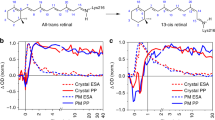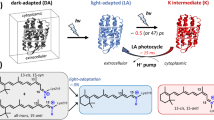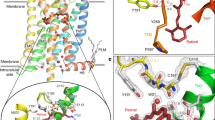Abstract
IT has been believed for some time that the primary event in vision, the photochemical formation of bathorhodopsin, can be attributed to a cis–trans photoisomerisation1. Recently this model has been questioned. Busch et al. proposed that the less-than-6-ps formation time of bathorhodopsin from rhodopsin does not allow significant isomerisation of the 11-cis chromophore to an all-trans isomer2. This apparent difficulty with the cis–trans photoisomerisation model has prompted alternative models including (1) a mechanism involving deprotonation of the Schiff base nitrogen3, (2) proton transfer from the retinal methyl at position five to opsin4,5 (involving the shifting of double bonds along the polyene chain to form a ‘retro’ type retinal), and (3) a photoinduced electron transfer to retinal from a protein donor group6. We have approached this question by performing picosecond absorption kinetic measurements on the formation time of bathorhodopsin from bovine rhodopsin and isorhodopsin. The essence of this experiment is that bathorhodopsin, being the common photo-product of rhodopsin (11-cis retinal) and isorhodopsin (9-cis retinal) must be an isomerised product of at least one of these pigments, but could be a product of both pigments (that is, basically all-trans retinal). Thus formation time measurements of bathorhodopsin from the two primary pigments can settle whether isomerisation can take place on the picosecond time scale.
This is a preview of subscription content, access via your institution
Access options
Subscribe to this journal
Receive 51 print issues and online access
$199.00 per year
only $3.90 per issue
Buy this article
- Purchase on Springer Link
- Instant access to full article PDF
Prices may be subject to local taxes which are calculated during checkout
Similar content being viewed by others
References
Hubbard, R. & Kropf, A. Proc. natn. Acad. Sci. U.S.A. 44, 130–139 (1958).
Busch, G. E., Applebury, M. L., Lamola, A. A. & Rentzepis, P. M. Proc. natn. Acad. Sci. U.S.A. 69, 2802–2806 (1972).
Thomson, A. J. Nature 254, 178–179 (1975).
Fransen, M. R. et al. Nature 260, 726–727 (1976).
van der Meer, K., Mulder, J. J. C. & Lugtenburg, J. Photochem. Photobiol. 24, 363–367 (1976).
Huppert, D., Rentzepis, P. M. & Kliger, D. S. Photochem. Photobiol. 25, 193–197 (1977).
Wald, G. Science 162, 230–239 (1968).
Ebrey, T. & Honig, B. Q. Rev. Biophys. 8, 124–184 (1975).
Honig, B. & Ebrey, T. A. Rev. Biophys. Bioengng 3, 151–177 (1974).
Hong, K. & Hubbell, W. L. Biochemistry 12, 4517–4523 (1973).
Oseroff, A. R. & Callender, R. H. Biochemistry 13, 4243–4248 (1974).
Dartnall, H. J. A. in Handbook of Sensory Physiology, V11/1, 122–145 (1972).
Rosenfeld, T., Honig, B., Ottolenghi, M., Hurley, J. & Ebrey, T. G. Pure appl. Chem. 49, 341–351 (1977).
Ricard, D., Lowdermilk, W. H. & Ducuing, J. Chem. Phys. Lett. 16, 617–621 (1972).
Callender, R. H. & Honig, B. A. Rev. Biophys. Bioengng. 6, 33–55 (1977).
Mathies, R., Oseroff, A. R., Freedman, T. B. & Stryer, L. in Tunable Laser Applications (eds Jaeger, T., Stokseth, P. & Mooradian, A. (Springer, New York, in the press).
Mathies, R., Freedman, T. B. & Stryer, L. molec. Biol. 109, 367–372 (1977).
Mathies, R., Oseroff, A. R. & Stryer, L. Proc. natn. Acad. Sci. U.S.A. 73, 1–5 (1976).
Warshel, A. Nature 260, 679–683 (1976).
Yoshizawa, T. & Wald, G. Nature 197, 1279–1286 (1963).
Duguay, M. A. & Hansen, J. W. Appl. Phys. Lett. 15, 192–194 (1969).
Author information
Authors and Affiliations
Rights and permissions
About this article
Cite this article
GREEN, B., MONGER, T., ALFANO, R. et al. Cis–trans isomerisation in rhodopsin occurs in picoseconds. Nature 269, 179–180 (1977). https://doi.org/10.1038/269179a0
Received:
Accepted:
Published:
Issue Date:
DOI: https://doi.org/10.1038/269179a0
This article is cited by
-
Isomeric effects tuning the electron transport in carotenoid derivatives: from ohmic to rectifier behavior
Journal of Molecular Modeling (2018)
-
Biological applications of picosecond spectroscopy
Nature (1983)
-
Spectroscopic and structural properties of metallo-proteins
La Rivista del Nuovo Cimento (1982)
-
Facts and hypotheses of molecular chemical tunnelling
Nature (1979)
Comments
By submitting a comment you agree to abide by our Terms and Community Guidelines. If you find something abusive or that does not comply with our terms or guidelines please flag it as inappropriate.



